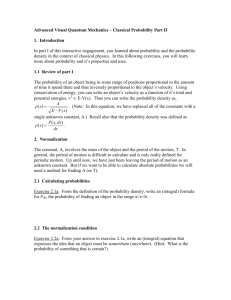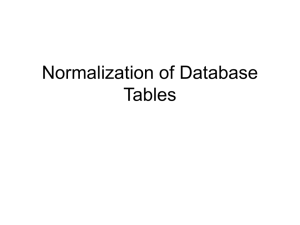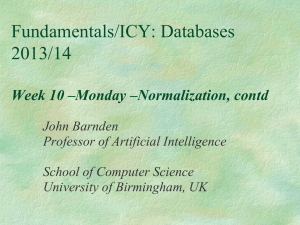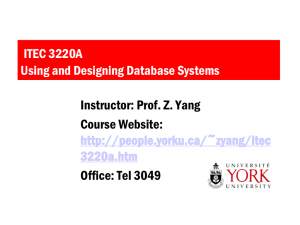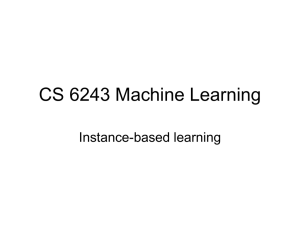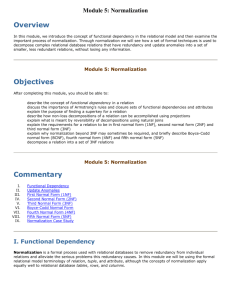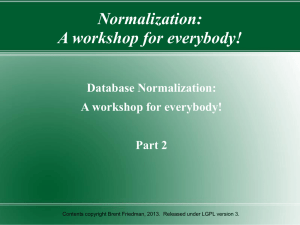Chapter # 5 (Normalization of Database Tables)
advertisement
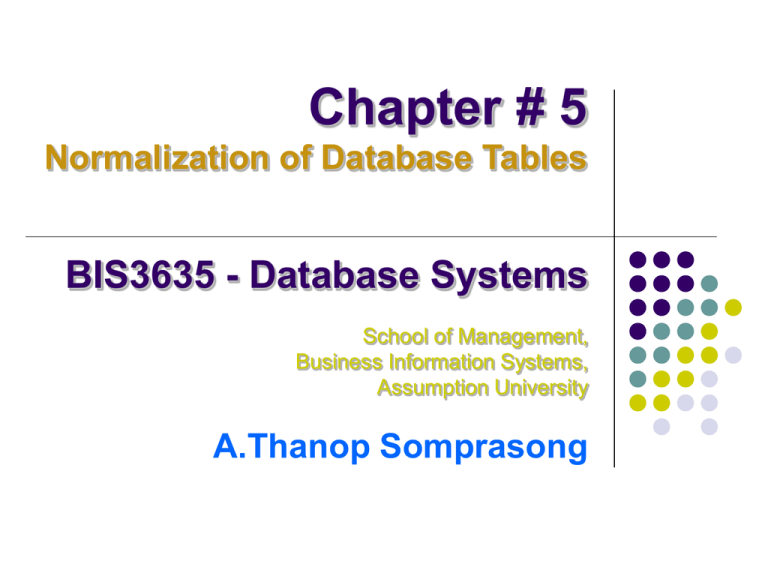
Chapter # 5 Normalization of Database Tables BIS3635 - Database Systems School of Management, Business Information Systems, Assumption University A.Thanop Somprasong Objectives In this chapter, you will learn: The main characteristics of entity relationship components How relationships between entities are defined, refined, and incorporated into the database design process How ERD components affect database design and implementation That real-world database design often requires the reconciliation of conflicting goals Database Tables and Normalization Normalization Process for evaluating and correcting table structures to minimize data redundancies Reduces data anomalies Works through a series of stages called normal forms: First normal form (1NF) Second normal form (2NF) Third normal form (3NF) Database Tables and Normalization (2) Normalization (continued) 2NF is better than 1NF; 3NF is better than 2NF For most business database design purposes, 3NF is as high as needed in normalization Highest level of normalization is not always most desirable Denormalization produces a lower normal form Price paid for increased performance is greater data redundancy The Need for Normalization Example: company that manages building projects Charges its clients by billing hours spent on each contract Hourly billing rate is dependent on employee’s position Periodically, report is generated that contains information such as displayed in Table 5.1 The Need for Normalization (2) The Need for Normalization (3) The Need for Normalization (4) Structure of data set in Figure 5.1 does not handle data very well Table structure appears to work; report generated with ease Report may yield different results depending on what data anomaly has occurred Relational database environment suited to help designer avoid data integrity problems The Normalization Process Each table represents a single subject No data item will be unnecessarily stored in more than one table All attributes in a table are dependent on the primary key Each table void of insertion, update, deletion anomalies The Normalization Process (2) The Normalization Process (3) Objective of normalization is to ensure all tables in at least 3NF Higher forms not likely to be encountered in business environment Normalization works one relation at a time Progressively breaks table into new set of relations based on identified dependencies The Normalization Process (4) Conversion to 1st Normal Form Repeating group Group of multiple entries of same type exist for any single key attribute occurrence Relational table must not contain repeating groups Normalizing table structure will reduce data redundancies Normalization is three-step procedure Conversion to 1st Normal Form (2) Step 1: Eliminate the Repeating Groups Eliminate nulls: each repeating group attribute contains an appropriate data value Step 2: Identify the Primary Key Must uniquely identify attribute value New key must be composed Step 3: Identify All Dependencies Dependencies depicted with a diagram Conversion to 1st Normal Form (3) Conversion to 1st Normal Form (4) Dependency diagram: Depicts all dependencies found within given table structure Helpful in getting bird’s-eye view of all relationships among table’s attributes Makes it less likely that you will overlook an important dependency Conversion to 1st Normal Form (5) Conversion to 1st Normal Form (6) First normal form describes tabular format in which: All key attributes are defined There are no repeating groups in the table All attributes are dependent on primary key All relational tables satisfy 1NF requirements Some tables contain partial dependencies Dependencies based on part of the primary key Should be used with caution Conversion to 2nd Normal Form Step 1: Write Each Key Component on a Separate Line Write each key component on separate line, then write original (composite) key on last line Each component will become key in new table Step 2: Assign Corresponding Dependent Attributes Determine those attributes that are dependent on other attributes At this point, most anomalies have been eliminated 2NF : A relation for which every non-primary key attribute is functionally dependent on the whole primary key. Source : Object-Oriented System Analysis and Design, 2nd Edition, Pearson International Edition Conversion to 2nd Normal Form (2) Conversion to 2nd Normal Form (3) Table is in second normal form (2NF) when: It is in 1NF and It includes no partial dependencies: No attribute is dependent on only portion of primary key Conversion to 3rd Normal Form Step 1: Identify Each New Determinant For every transitive dependency, write its determinant as PK for new table Determinant: any attribute whose value determines other values within a row Step 2: Identify the Dependent Attributes Identify attributes dependent on each determinant identified in Step 1 Identify dependency Name table to reflect its contents and function Conversion to 3rd Normal Form (2) Step 3: Remove the Dependent Attributes from Transitive Dependencies Eliminate all dependent attributes in transitive relationship(s) from each of the tables Draw new dependency diagram to show all tables defined in Steps 1–3 Check new tables as well as tables modified in Step 3 Each table has determinant No table contains inappropriate dependencies 3NF : A relation that is in second normal form and that has no transitive dependencies between two (or more) non-primary key attributes. Source : Object-Oriented System Analysis and Design, 2nd Edition, Pearson International Edition Conversion to 3rd Normal Form (3) Conversion to 3rd Normal Form (4) A table is in third normal form (3NF) when both of the following are true: It is in 2NF It contains no transitive dependencies Improving the Design Table structures cleaned up to eliminate initial partial and transitive dependencies Normalization cannot, by itself, be relied on to make good designs It is valuable because its use helps eliminate data redundancies Improving the Design (2) Issues to address in order to produce a good normalized set of tables: Evaluate PK Assignments Evaluate Naming Conventions Refine Attribute Atomicity Identify New Attributes Identify New Relationships Refine Primary Keys as Required for Data Granularity Maintain Historical Accuracy Evaluate Using Derived Attributes Improving the Design (3) Surrogate Key Considerations When primary key is considered to be unsuitable, designers use surrogate keys* Data entries in Table 5.3 are inappropriate because they duplicate existing records No violation of entity or referential integrity Surrogate Key* : A surrogate key in a database is a unique identifier for either an entity in the modeled world or an object in the database. Source : Wikipedia Higher-Level Normal Forms Tables in 3NF perform suitably in business transactional databases Higher order normal forms useful on occasion Two special cases of 3NF: Boyce-Codd normal form (BCNF) Fourth normal form (4NF) The Boyce-Codd Normal Forms (BCNF) Every determinant in table is a candidate key Has same characteristics as primary key, but for some reason, not chosen to be primary key When table contains only one candidate key, the 3NF and the BCNF are equivalent BCNF can be violated only when table contains more than one candidate key The Boyce-Codd Normal Forms (BCNF) (2) Most designers consider the BCNF as special case of 3NF Table is in 3NF when it is in 2NF and there are no transitive dependencies Table can be in 3NF and fail to meet BCNF No partial dependencies, nor does it contain transitive dependencies A nonkey attribute is the determinant of a key attribute The Boyce-Codd Normal Forms (BCNF) (3) The Boyce-Codd Normal Forms (BCNF) (4) The Boyce-Codd Normal Forms (BCNF) (5) 4rd Normal Form (4NF) Table is in fourth normal form (4NF) when both of the following are true: It is in 3NF No multiple sets of multivalued dependencies 4NF is largely academic if tables conform to following two rules: All attributes dependent on primary key, independent of each other No row contains two or more multivalued facts about an entity 4rd Normal Form (4NF) (2) 4rd Normal Form (4NF) (3) Normalization and Database Design Normalization should be part of the design process Make sure that proposed entities meet required normal form before table structures are created Many real-world databases have been improperly designed or burdened with anomalies You may be asked to redesign and modify existing databases Normalization and Database Design (2) ER diagram Identify relevant entities, their attributes, and their relationships Identify additional entities and attributes Normalization procedures Focus on characteristics of specific entities Micro view of entities within ER diagram Difficult to separate normalization process from ER modeling process Normalization and Database Design (3) Normalization and Database Design (4) Normalization and Database Design (5) Normalization and Database Design (6) Normalization and Database Design (7) Denormalization Creation of normalized relations is important database design goal Processing requirements should also be a goal If tables decomposed to conform to normalization requirements: Number of database tables expands Denormalization (2) Joining the larger number of tables reduces system speed Conflicts often resolved through compromises that may include denormalization Defects of unnormalized tables: Data updates are less efficient because tables are larger Indexing is more cumbersome No simple strategies for creating virtual tables known as views THE END
